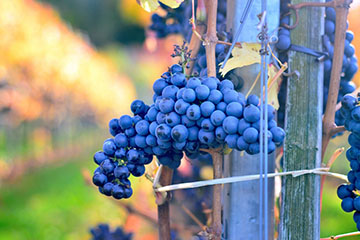 Written by Alex Russan
Written by Alex Russan
How ripe your grapes are when picked is one of the most important factors in determining what your wine will taste like. Delicious wines of drastically different styles can be made from the exact same vines, simply as a result of harvest time (viticultural practices make a big difference as well). From a consumer perspective, you can see production trends these days shifting from the very ripe styles of the 90s and 2000s (big, lush, powerful wines), to much less ripe offerings (lighter, fresher, elegant wines), with many of these lighter wines being produced from the same vineyards that their bigger counterparts come from. As a home winemaker (and often as a commercial one), if you are purchasing grapes, pick time may be the one factor in the vineyard you can control, and, thankfully, it is a huge one!
This article is a journey in the life of a grape from under- to over-ripeness. From bright fruit to dark, earth to opulence, pyrazines to field oxidation. All grapes develop in their own ways, so to an extent these are generalizations that may not always be the case for all grapes of all sites, but it is a solid guide, aiming to help you harvest at the moment that will be most parallel with your stylistic goals as a winemaker.
Let’s get something out in the open here: The concept of ripeness is a moving target, and, quite frankly, a bit of a mess! Ripeness does not progress in a simple linear fashion. All of the different factors that determine ripeness develop somewhat, or entirely, independently of one another, and each will have a different pace every year. Vineyard management practices will also affect the pace of many factors. Sugar levels, acidity levels, and grape taste are the most common parameters used to decide when to pick, but there are many more — 20 worth considering, according to the insightful Winegrape Berry Assessment Handbook by Winter, Whiting, and Rousseau!
If you’re growing your own grapes, you’re able to pick at will, and micromanagement of any and all ripening variables is an option. For the rest of us who are purchasing grapes, however, Brix and, perhaps, acidity levels will likely be the only indicators of ripeness we will receive prior to requesting a harvest date. That being the case, understanding the grape variety and site is crucial to understanding how “ripe” the grapes will be (and how close they will be developmentally) relative to those numbers — which, to be clear, are very important numbers, but do not tell the entire story.
For example, a Chardonnay picked at 21 °Brix in a hot climate will be very different than that of a cool climate: The hot climate will be well into tropical aromatics with lower acid, whereas the cool climate will remain on the stony and citric side and contain more acid. In the same vein, a Chardonnay picked at 3.1 pH in the hot climate would likely be grossly underripe and green, with very low sugars, whereas the cool climate may be well developed with reasonable sugar levels. Understanding where the different ripening variables will be relative to one another for a grape in a specific climate is paramount to picking at the moment that will lead to the wine you want.
The same goes for vintage variation, although you cannot completely control the pace of the many ripening variables (and vertical tastings would be boring if you could!), you can choose to pick earlier or later, aiming to keep the wine in line with your style goals and for what would be best for that vintage.
A factor I rarely hear discussed, and one I consider of the utmost importance to pick decisions, is the stage of aromatic development of the grape at the time of picking. This, of course, is not a factor that can currently be measured and is also one of the only factors that cannot be directly manipulated post-harvest. Brix, acidity levels, tannin, and color can all be measured, as well as manipulated after harvest. Beyond what the grape provides, aromatics can only be imprecisely tinkered with via yeast selection, added to with oak, or, especially in whites, use of enzyme preparations high in beta-glucosidases. The type of aromatics a grape will yield change tremendously during ripening, and, I believe, so does the degree to which a grape can express its individual terroir.
Of course, matching an appropriate grape variety to a vineyard site is critical in growing grapes in which ripeness characteristics will come together harmoniously in most years. In vintages or areas where they do not, the aforementioned manipulations or additions may be necessary.
